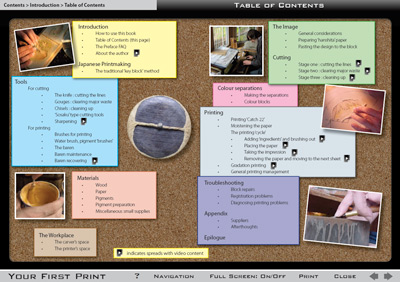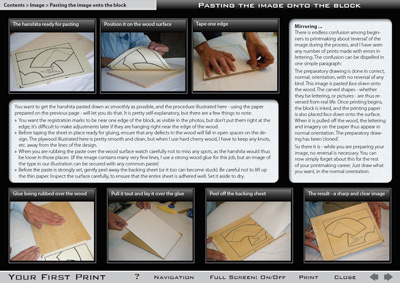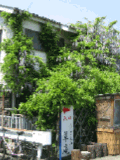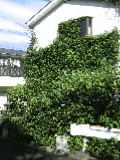Forgotten Beauty of Woodblock Prints (V)
In all the parts of this ‘documentary’ series that we have ‘watched’ to date, we have seen Dave in his capacity as a craftsman re-creating traditional designs from the past. This episode will show us another aspect to his printmaking - the creation of his own original designs.
The Forgotten Beauty of Japanese Woodblock Prints
[Part Five - A Change of Direction]
Scene One : [Camera] This segment of the program opens with a shot of surf rolling in on a beach. We pan around and take in the scene: the wide open sea in front of us, the long - and deserted - beach, the cliffs immediately behind, with hawks soaring above on the air currents. We notice some footprints in the sand - bare feet - and begin to follow them.
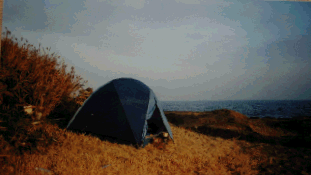 The footprints move up the beach away from the water, and we pan the camera up to see where they head. A tent. A small blue tent, nestled near protective bushes, with its doorway facing the sea. The door flap is open, and a small camp stove and other items are seen, but nobody is here.
The footprints move up the beach away from the water, and we pan the camera up to see where they head. A tent. A small blue tent, nestled near protective bushes, with its doorway facing the sea. The door flap is open, and a small camp stove and other items are seen, but nobody is here.
We pan back out to the shore, looking for the camper. There he is! Sitting at the end of the nearby group of rocks jutting into the sea. His hair is blowing in the gusty breeze; he sits peacefully, looking out to sea.
[David - voice-over (excerpt from one of his ‘My Solitudes’ books)]: “Down on the beach it is wonderfully fresh and clean. The sun is beaming on the bright sand, and a brisk breeze is blowing. The weather report this morning was vague, promising a bit of everything over the next 24 hours, but at the moment only a few white clouds patch the sky here and there, and don’t threaten to spoil the mood. ... All in all, I am surrounded by a wonderful sensation of space and openness.“
[Camera] We fade from Dave, and the camera view returns to the tent. Dave is making tea on the little camp stove, and talks with the unseen interviewer.
[Interviewer] “How long have you been coming here? I had no idea there was such a deserted beach so close to Tokyo, here at ...”
[David cuts him off immediately] “No! Don’t tell your viewers where this place is! I spent a great deal of effort to find a deserted place like this, and (laughs) I’d like it to stay that way!
“I first came here in around 1996, and I’ve been coming back ever since. I have a small personal ‘collection’ of these private natural places, and it’s my habit to sometimes put the work aside, grab my tent and a few supplies, and ‘get away from it all’. I usually stay for 24 hours, arriving in the afternoon, spending the night, and most of the next day, then heading home.”
[Interviewer] “You always come alone? What do you do while you are here?”
[David] “Yes, always alone. That’s kind of the point. Most of us these days live with so much noise and activity around us all day, that it is actually difficult to sit quietly. For me it is important that I have a chance to do that sometimes. When I come here, I do nothing. Of course I can’t stop thinking, but at least I don’t run around exploring, and trying to ‘keep busy’. I just sit and enjoy the scenery.”
[Interviewer] “Aren’t you a bit afraid, being out here by yourself?”
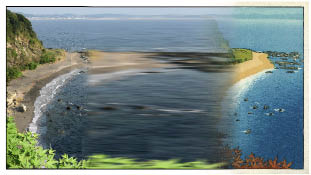 [David] “Well, for a man anyway, I don’t think that’s a problem. And if you mean ‘wild animals’, there simply aren’t any creatures out here that would harm anybody. In fact, the ‘wildlife’ becomes one of the main attractions for me. There are so many creatures that you are able to see - and from up very close - if you just sit still and be quiet.”
[David] “Well, for a man anyway, I don’t think that’s a problem. And if you mean ‘wild animals’, there simply aren’t any creatures out here that would harm anybody. In fact, the ‘wildlife’ becomes one of the main attractions for me. There are so many creatures that you are able to see - and from up very close - if you just sit still and be quiet.”
[Camera] We now see a shot of the entire cove where David is camping. Far below is his tiny tent. It is a beautiful day, seagulls are crying, and the gentle surf is sliding up and down the beach in a steady rhythm. The focus becomes slightly blurred, and the image we see morphs into ... David’s woodblock print of exactly the same scene ... [Wipe]
Scene Two : [Camera] The next segment of the program takes place at the river, opening with a close-up shot of the stream bouncing over ripples. The camera pans up to take in a view of the water surface, and we then take in the wider scene: a quite deep valley, with thickly forested walls holding the river close. We slowly pan along the riverbank; tumbled boulders in some places, small sandy ‘beaches’ in others. We see the same blue tent. As before, the door flap is open, but nobody is there.
A moment later we ‘find’ Dave, leaning back in his ‘favourite’ place - a sunny spot on some rocks overlooking the river flow. He is scribbling in his notebook ...
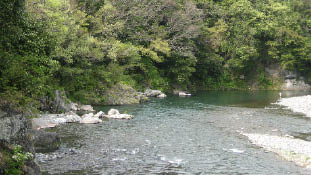 [David - voice-over (excerpt from another of the ‘My Solitudes’ books)]: “If I had been trying to design a good location for this little adventure, I couldn’t have done better. The valley is deep, and the sides are steep and heavily forested. To see open sky I must crane my neck back sharply. The river here is in places shallow enough to walk across, in other places deep and mysterious; alternately rough and gentle, headstrong and lazy, it flows past the green valley walls. The riverbank opposite is a wide strand of gravel, presumably piled up by the water in typhoon season, but the side where I sit is quite different - mostly large boulders and broken cliffs.“
[David - voice-over (excerpt from another of the ‘My Solitudes’ books)]: “If I had been trying to design a good location for this little adventure, I couldn’t have done better. The valley is deep, and the sides are steep and heavily forested. To see open sky I must crane my neck back sharply. The river here is in places shallow enough to walk across, in other places deep and mysterious; alternately rough and gentle, headstrong and lazy, it flows past the green valley walls. The riverbank opposite is a wide strand of gravel, presumably piled up by the water in typhoon season, but the side where I sit is quite different - mostly large boulders and broken cliffs.“
[Camera] We fade from Dave, and the camera view again returns to the tent. Dave again talks with the unseen interviewer.
[Interviewer] “I see what you mean when you say ‘private places.’ There is absolute nobody around here at all. And yet we are still well within the boundaries of Tokyo!”
[David] “Amazing, isn’t it! Yes, this is another of my special ‘retreats’. I have three of them; you have seen the seacoast, now we are at the riverside, and later we will venture into the forest. Each place has its own character of course, and the various animals and birds that visit me are different, but they all share that same absolute peace and privacy.”
[Interviewer] “But I have to say, it’s a bit chilly today for a camping trip, don’t you think?”
[David] (laughs) “Not over there where I was sitting on those rocks! They have been warmed by the sun, and that place is protected from the breeze by the nearby trees.You think it is cold today, you should be back here with me in February!”
[Interviewer] “You come here in winter too? Camping?”
[David] “Sure! As a friend of ours likes to say, ‘There is no such thing as bad weather, just poor choice of clothing!’ I have made it a habit to visit all these places in every season. Of course I don’t come here in the middle of a typhoon, or anything like that, but I don’t shy away from inclement weather. I have slept here in the pouring rain, when there is ice forming at the edge of the water, on foggy days, and of course, on any number of days when the weather is picture perfect.
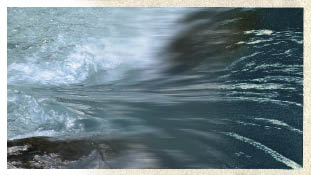 “That’s part of the magic of doing this - getting to know each place in all weathers and all seasons. You can never really come to know a place well until you have seen it that way. And have you ever seen the full moon in the depths of winter, high in an absolutely crystal clear sky? It’s an experience nobody should miss!”
“That’s part of the magic of doing this - getting to know each place in all weathers and all seasons. You can never really come to know a place well until you have seen it that way. And have you ever seen the full moon in the depths of winter, high in an absolutely crystal clear sky? It’s an experience nobody should miss!”
[Interviewer] “Well, I’m not sure ... it just seems so chilly ...”
[David] “Here, have a cup of this hot soup; it’ll soon change your mind! And I don’t mind your reluctance at all; the fewer people who come here - the more peaceful it will stay for me!”
[Camera] We now see a close-up shot of the water again. Blue-green water is rushing down a small slope to erupt in a cascade of foam at the bottom. Our eyes are mesmerized by the sweep of the water ... The focus becomes slightly blurred, and the image we see morphs into ... David’s woodblock print of exactly the same scene ... [Wipe]
Scene Three : [Camera] The final segment of this part of our program is filmed in the forest. It seems to be autumn. The sky is blue, the air is full of birdsong, the camera pans around the woodland.
We sequence through a number of closeups: a clump of mushrooms on the forest floor, the beautiful bark of a fallen tree, an ant carrying a huge leaf cutting back to the next. We hear - off in the distance - the sound of somebody walking over the carpet of fallen leaves.
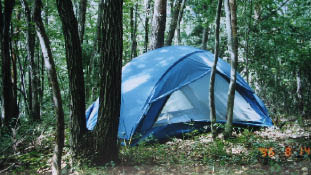 The camera pans across the forest, but we can see nobody. Then, here and there - alternately hidden then exposed by the tree trunks - we get a glimpse of somebody walking. It is David, returning to his tent, where we join him.
The camera pans across the forest, but we can see nobody. Then, here and there - alternately hidden then exposed by the tree trunks - we get a glimpse of somebody walking. It is David, returning to his tent, where we join him.
[Interviewer] “This is incredible. We left your house together just a short time ago, and yet here we are in the depths of a forest. I can’t hear the slightest sound from the city below.”
[David] “Yes, the forest does soon wrap you up in itself. In the evening, sitting in my tent, I do sometimes hear sounds; the evening chimes are quite ‘nostalgic’ when heard from a distance, up here.
“Compared to the seacoast and the river, the woodland is by far the most peaceful of my private places. With no moving water to always capture your attention, one’s thoughts soon turn inward.”
[Interviewer] “To ...”
[David] “Well when I first started coming to these places, it was just for relaxation, but a few years back, I realized that there was a wonderful theme for my printmaking waiting for me here.
“Three beautiful places ... seen in four seasons ... I couldn’t resist the idea. So this was the impetus for the ‘My Solitudes’ print series. It is made up of 12 prints, but is more than ‘just’ prints. You saw me with my notebook earlier; I was collecting material for the story that will accompany the next print in my series.”
[Interviewer] “You say ‘story’; is this something fictional?”
[David] “No, nothing like that. Simply I keep notes about what ‘happens’ during the course of each trip. As I mentioned, I’m at each place for about 24 hours, and there is always so much to see and experience! Some ‘episodes’ may be very quiet and mundane - watching a flower open - and others are much more dramatic - a hawk splashing into the river to catch a fish, or a flying squirrel soaring across the river to a tree on the other side. My notebooks become stuffed!”
[Interviewer] “And you then go home and create a print based on what you have experienced.”
[David] “Yes, exactly. My prints are not ‘action scenes’ though - no diving hawks - but are quiet representations of each location, seen of course at a particular season.”
[Interviewer] “This has been quite a dramatic change for you, from making reproductions of old prints, to creating new originals. How has it gone?”
[David] “It has been one of the most difficult things I have ever done! I have of course seen art all my life; we are all surrounded by it. But to create my own ... This is a different story.
“Imagine a child who has been brought up in a particular country, listening to the language around him every day, but never speaking. Then, finally one day, he decides to try using language for himself, and opens his mouth to speak. Will he be able to express himself well?
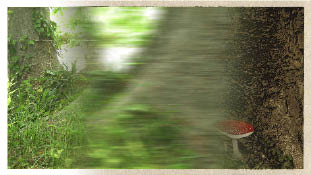 “In my case, I am still not sure just how well I have managed to express myself in this ‘new’ language. Reaction from people who are collecting the series has been very positive though, so I think that perhaps my efforts are not so bad.”
“In my case, I am still not sure just how well I have managed to express myself in this ‘new’ language. Reaction from people who are collecting the series has been very positive though, so I think that perhaps my efforts are not so bad.”
[Interviewer] “The set of 12 is nearly complete. Will you then begin another series of original designs?”
[David] “Nothing on that is yet decided. I think that from now on, making prints of my own design will simply be another string to my bow. I love making all kinds of prints, and will definitely not ‘give up’ making them on the old patterns too. Next year? We’ll see soon!”
[Camera] We now see a close-up shot of the base of a tree trunk. Perhaps some ants are scurrying back and forth. The pattern of the bark is quite distinctive. And as before, the focus becomes slightly blurred, and the image we see morphs into ... David’s woodblock print of exactly the same scene. The book then closes, and we fade on a view of the decorated cover ...
[End Part Five]
In the next issue, in Part Six, our ‘program’ wraps up with a look at what the future may hold for Dave, and for the craft he has followed for so many years ...
 Did somebody tell me that ‘sevens’ are lucky? Well it’s going to be quite a while before we get to issue #777 of this newsletter, so we’ll have to be content with only two sevens!
Did somebody tell me that ‘sevens’ are lucky? Well it’s going to be quite a while before we get to issue #777 of this newsletter, so we’ll have to be content with only two sevens!


 The footprints move up the beach away from the water, and we pan the camera up to see where they head. A tent. A small blue tent, nestled near protective bushes, with its doorway facing the sea. The door flap is open, and a small camp stove and other items are seen, but nobody is here.
The footprints move up the beach away from the water, and we pan the camera up to see where they head. A tent. A small blue tent, nestled near protective bushes, with its doorway facing the sea. The door flap is open, and a small camp stove and other items are seen, but nobody is here. [David] “Well, for a man anyway, I don’t think that’s a problem. And if you mean ‘wild animals’, there simply aren’t any creatures out here that would harm anybody. In fact, the ‘wildlife’ becomes one of the main attractions for me. There are so many creatures that you are able to see - and from up very close - if you just sit still and be quiet.”
[David] “Well, for a man anyway, I don’t think that’s a problem. And if you mean ‘wild animals’, there simply aren’t any creatures out here that would harm anybody. In fact, the ‘wildlife’ becomes one of the main attractions for me. There are so many creatures that you are able to see - and from up very close - if you just sit still and be quiet.” [David - voice-over (excerpt from another of the ‘My Solitudes’ books)]: “If I had been trying to design a good location for this little adventure, I couldn’t have done better. The valley is deep, and the sides are steep and heavily forested. To see open sky I must crane my neck back sharply. The river here is in places shallow enough to walk across, in other places deep and mysterious; alternately rough and gentle, headstrong and lazy, it flows past the green valley walls. The riverbank opposite is a wide strand of gravel, presumably piled up by the water in typhoon season, but the side where I sit is quite different - mostly large boulders and broken cliffs.“
[David - voice-over (excerpt from another of the ‘My Solitudes’ books)]: “If I had been trying to design a good location for this little adventure, I couldn’t have done better. The valley is deep, and the sides are steep and heavily forested. To see open sky I must crane my neck back sharply. The river here is in places shallow enough to walk across, in other places deep and mysterious; alternately rough and gentle, headstrong and lazy, it flows past the green valley walls. The riverbank opposite is a wide strand of gravel, presumably piled up by the water in typhoon season, but the side where I sit is quite different - mostly large boulders and broken cliffs.“ “That’s part of the magic of doing this - getting to know each place in all weathers and all seasons. You can never really come to know a place well until you have seen it that way. And have you ever seen the full moon in the depths of winter, high in an absolutely crystal clear sky? It’s an experience nobody should miss!”
“That’s part of the magic of doing this - getting to know each place in all weathers and all seasons. You can never really come to know a place well until you have seen it that way. And have you ever seen the full moon in the depths of winter, high in an absolutely crystal clear sky? It’s an experience nobody should miss!” The camera pans across the forest, but we can see nobody. Then, here and there - alternately hidden then exposed by the tree trunks - we get a glimpse of somebody walking. It is David, returning to his tent, where we join him.
The camera pans across the forest, but we can see nobody. Then, here and there - alternately hidden then exposed by the tree trunks - we get a glimpse of somebody walking. It is David, returning to his tent, where we join him. “In my case, I am still not sure just how well I have managed to express myself in this ‘new’ language. Reaction from people who are collecting the series has been very positive though, so I think that perhaps my efforts are not so bad.”
“In my case, I am still not sure just how well I have managed to express myself in this ‘new’ language. Reaction from people who are collecting the series has been very positive though, so I think that perhaps my efforts are not so bad.”
